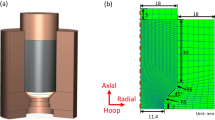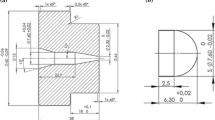Abstract
Metal extrusion as one of the production processes for semi-finished products plays an important role for the optimisation of wrought magnesium alloys. A mechanistic approach for the modelling of the coupled deformation and temperature fields is presented here. It accounts for the strain rate and temperature dependence of the mechanical properties as well as for the evolution of anisotropy and tension-compression asymmetry of magnesium alloys. In an attempt to calibrate the model parameter, tension and compression tests at different temperatures and strain rates are conducted for two different alloys, namely ZE10 and ZEK100. Extrusion trials are simulated and the predicted results are compared in terms of punch force and temperature history. Conclusions are formulated with respect to the significance of model parameters.








Similar content being viewed by others
References
Extrusion (2006). 2 edn. ASM International, Materials Park, Ohio
Chinesta F, Cueto E, Moe PT, Stören S, Huetink H (2007) Hot metal extrusion. In: Advances in Material Forming. Springer Paris, pp 207–223. doi:10.1007/978-2-287-72143-4_12
Yoo MH (1981) Slip, twinning, and fracture in hexagonal close-packed metals. Metall Trans A 12A:409–418
Barnett MR (2007) Twinning and the ductility of magnesium alloys: Part I: “Tension” twins. Materials Science and Engineering: A 464(1–2):1–7
Hosford WF (1993) The mechanics of crystals and textured polycrystals. Oxford University Press, New York
Kaiser F, Letzig D, Bohlen J, Styczynski A, Hartig C, Kainer KU (2003) Anisotropic properties of magnesium sheet AZ31. In: Kojima Y, Aizawa T, Higashi K, Kamado S (eds) Magnesium Alloys 2003, Pts 1 and 2, vol 419–4. Materials Science Forum. pp 315–320
Bohlen J, Nuernberg MR, Senn JW, Letzig D, Agnew SR (2007) The texture and anisotropy of magnesium–zinc–rare earth alloy sheets. Acta Mater 55:2101–2112
Peirce D, Asaro RJ, Needleman A (1983) Material rate dependence and localized deformation in crystalline solids. Acta Metall 31(12):1951–1976
Lebensohn RA, Tomé CN (1994) A self-consistent viscoplastic model: prediction of rolling textures of anisotropic polycrystals. Materials Science and Engineering: A 175(1–2):71–82
Staroselsky A, Anand L (2003) A constitutive model for hcp materials deforming by slip and twinning: application to magnesium alloy AZ31B. Int J Plast 19(10):1843–1864
Graff S, Brocks W, Steglich D (2007) Yielding of magnesium: from single crystal to polycrystalline aggregates. Int J Plast 23(12):1957–1978
Tadano Y (2010) Polycrystalline behavior analysis of pure magnesium by the homogenization method. Int J Mech Sci 52(2):257–265
Cazacu O, Barlat F (2004) A criterion for description of anisotropy and yield differential effects in pressure-insensitive metals. Int J Plast 20(11):2027–2045
Ertürk S (2009) Thermo-mechanical modelling and simulation of magnesium alloys during extrusion process PhD. Thesis, CAU zu Kiel, Kiel
Drucker DC (1964) On the postulate of stability of material in the mechanics of continua. Journal de Mécanique 3(2):235–249
Drucker DC (1949) Relation of experiments to mathematical theories of plasticity. J Appl Mech 71: 349–357
Betten J (1979) Über die Konvexität von Fließkörpern isotroper und anisotroper Stoffe. Acta Mech 32:233–247
Chung K, Lee M-G, Kim D, Kim C, Wenner ML, Barlat F (2005) Spring-back evaluation of automotive sheets based on isotropic-kinematic hardening laws and non-quadratic anisotropic yield functions: Part I: theory and formulation. Int J Plast 21(5):861–882
Hill R (1948) A theory of the yielding and plastic flow of anisotropic metals. Proc Roy Soc London A 193:281–297
Graff S (2007) Micromechanical modeling of deformation in hcp metals. Technische Universität, Berlin, D
Chaboche JL, Rousselier G (1983) On the plastic and viscoplastic constitutive equations—Part I: rules developed with internal variables. J Press Vessel Techn 105:153–158
Kelley EW, Hosford WF (1968) Plane-strain compression of magnesium and magnesium alloy crystals. Trans Metall Soc AIME 242:5–13
Kelley EW, Hosford WF (1968) The deformation characteristics of textured magnesium. Trans Metall Soc AIME 242:654–661
Ertürk S, Steglich D, Bohlen J, Letzig D, Brocks W. Modelling of thermo-mechanical behaviour of magnesium alloys during indirect extrusion. In: Tekkaya AE, Khalifa NB (eds) Advances on hot extrusion and simulation of light alloys, vol 424. Key Engineering Materials. pp 167–171. doi:10.4028/www.scientific.net/KEM.424.167
Schwefel H-P (1995) Evolution and optimum seeking. Wiley-Interscience Publication, New York
Rechenberg I (1994) Evolutionsstrategie ‘94. Werkstatt Bionik und Evolutionstechnik, Band1 edn. Frommann-Holzboog Verlag, Stuttgart
Taylor GI, Quinney H (1934) The latent energy remaining in a metal after cold working. Proceedings of the Royal Society of London Series a-Mathematical and Physical Sciences 143(A849):307–326
Bever MB, Holt DL, Titchener AL (1973) The stored energy of cold work. Prog Mater Sci 17:5–177
Acknowledgements
The extrusion model presented here is part of the PhD thesis of S.E. The authors gratefully acknowledge the financial support for the project “Description of thermo-mechanical processes during extrusion of aluminium free magnesium alloys” by the German Research Association (DFG) under contract number BO 2461/1. They also thank Prof. Walter Reimers and Dr. Hans-Michael Mayer from the Technical University Berlin as well as Dr. Sören Müller from the Extrusion Research and Development Center of the same university for the tests executed within the project and presented above. The authors furthermore like to acknowledge the extensive discussion and the help of M. Nebebe during the realisation of the parameter calibration procedure.
The work was finalised during a sabbatical leave of D.S. at the Graduate Institute of Ferrous Technology (G.I.F.T.) of POSTECH, Pohang, South Korea as part of an international outgoing fellowship (Marie Curie Actions) of the 7th programme of the European Commission. The authors deeply acknowledge this support and hereby point out that the EU is not responsible for the content of this paper.
Author information
Authors and Affiliations
Corresponding author
Rights and permissions
About this article
Cite this article
Ertürk, S., Brocks, W., Bohlen, J. et al. A constitutive law for the thermo-mechanical modelling of magnesium alloy extrusion. Int J Mater Form 5, 325–339 (2012). https://doi.org/10.1007/s12289-011-1055-6
Received:
Accepted:
Published:
Issue Date:
DOI: https://doi.org/10.1007/s12289-011-1055-6




